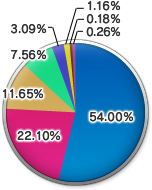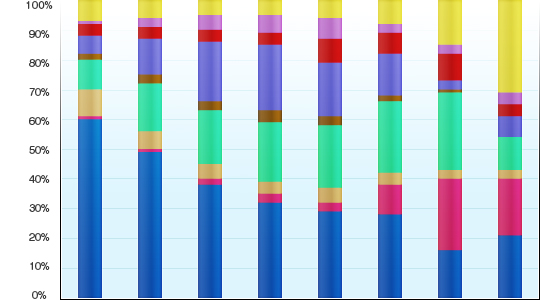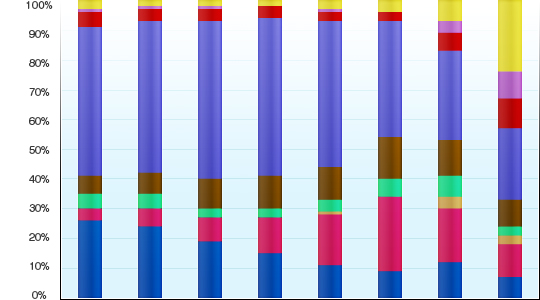Economics
Why don’t we stop to take a look at the most important thing to every practical adventurer, their gil!
 |
|
First, take a look at the graph indicating how much income players make each week.
Roughly half of the adventurers who answered the survey make under 50,000 gil. Additionally, because players who make under 100,000 gil amount to around 75% of all players, we can consider this range to be the average weekly income.
Next, we move on to the sources of this income divided by income range.
 |
||||||||||||||||||||||||||
| 0 - 50,000 gil. | 50,000 - 100,000 gil. | 100,000 - 200,000 gil. | 200,000 - 500,000 gil. | 500,000 - 1,000,000 gil. | 1,000,000 - 5,000,000 gil. | 5,000,000 - 10,000,000 gil. | Over 10 million gil. | |||||||||||||||||||
|
||||||||||||||||||||||||||
This graph’s data was taken from the same survey and indicates which methods were used to obtain the weekly income in the first graph.
Up until around 100,000 gil, the main source of income is selling items won in combat, which makes up about half of the answers. As the income increases, the percentage of players selling items won in combat steadily decreases and the percentage of players selling the right to obtain rare items in combat increases. It is clear that selling the right to obtain rare items in combat is a valuable source of income for players making over 5 million gil.
Income from synthesis and gardening is particularly striking. There is no real major difference between gardening and synthesis’ percentages up until around 1 million gil where the percentage of synthesis exceeds gardening and continues to do so as the income range increases. This is representative of gardening’s reputation for being a stable source of income that requires little investment and synthesis’ characteristic as an unstable source of income that can offer large profits to players with expensive materials and high synthesis skills.
 |
||||||||||||||||||||||||||||
| 0 - 50,000 gil. | 50,000 - 100,000 gil. | 100,000 - 200,000 gil. | 200,000 - 500,000 gil. | 500,000 - 1,000,000 gil. | 1,000,000 - 5,000,000 gil. | 5,000,000 - 10,000,000 gil. | Over 10 million gil. | |||||||||||||||||||||
|
||||||||||||||||||||||||||||
Lastly, we take a look at the ways players spend their income. Like the previous graph, this one has also been based on survey results and divided by income range.
The number one thing players in all income ranges spend their money on is equipment based on its functionality and performance. It may very well be that the desire to continually gain strength lies in all adventurers’ hearts. On the other hand, while it’s not a significant amount, the percentage of players purchasing equipment based on its appearance starts to increase after 5 million gil. This may be due to the freedom of the wealthy to spend their money on whatever they desire.
In the previous section, we mentioned that the percentage of players selling the right to obtain rare items in combat increases as the income range does, but likewise, the percentage of players purchasing items necessary for obtaining certain equipment and notorious monster trigger items also increases with the income range. We believe this is due to players wanting to obtain items that could not be purchased at bazaars or auction houses, or wanting to sell the right to obtain rare items in combat to make even more gil.
The reason synthesis materials hold roughly the same percentage across the board is probably due to players whose source of income is synthesis purchasing these materials regardless of their income range.
 |
 |








